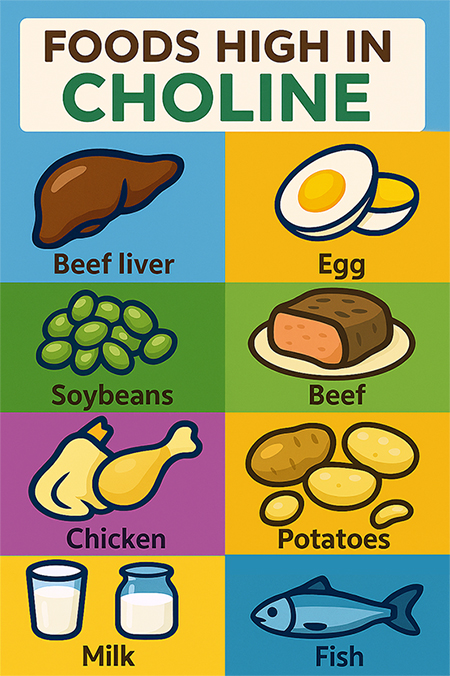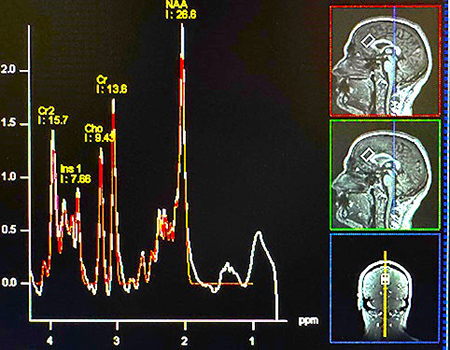People with anxiety disorders have lower levels of choline in their brains, according to research from UC Davis Health.

The study, published in the Nature journal Molecular Psychiatry, analyzed data from 25 studies. The researchers compared the levels of neurometabolites — chemicals produced during brain metabolism — in 370 people with anxiety disorders to 342 people without anxiety.
They found the level of choline — an essential nutrient — was about 8% lower in those with anxiety disorders. The evidence for low choline was especially consistent in the prefrontal cortex, the part of the brain that helps control thinking, emotions and behavior.
"This is the first meta-analysis to show a chemical pattern in the brain in anxiety disorders," said Jason Smucny, co-author and an assistant professor in the Department of Psychiatry and Behavioral Sciences. "It suggests nutritional approaches — like appropriate choline supplementation — may help restore brain chemistry and improve outcomes for patients."
Choline (pronounced KOE lean) is vital for cell membranes and brain functions like memory, mood regulation and muscle control. The body makes a small amount, but most must come from food.
Anxiety disorders affect about 30% of adults
Richard Maddock, senior author of the study, is a psychiatrist and research professor in the Department of Psychiatry and Behavioral Sciences. He is also a researcher at the UC Davis Imaging Research Center, which uses magnetic resonance imaging (MRI) techniques to study brain health.
Maddock spent decades in clinical practice treating patients with anxiety disorders and conducting research on these conditions.
"Anxiety disorders are the most common mental illness in the United States, affecting about 30% of adults. They can be debilitating for people, and many people do not receive adequate treatment," Maddock said.
Anxiety disorders include:
Anxiety disorders are the most common mental illness in the United States, affecting about 30% of adults. They can be debilitating for people, and many people do not receive adequate treatment."-Richard Maddock, psychiatrist and research professor, Department of Psychiatry and Behavioral Sciences.
Brain interactions affect anxiety
Anxiety disorders are linked to how different parts of the brain — like the amygdala, which influences our sense of safety or danger, and the prefrontal cortex, which is involved in planning and decision-making — respond to stress or potential threats.
Anxiety disorders are also linked to imbalances in neurotransmitters. For example, norepinephrine — part of the body's "fight-or-flight" response — is often elevated in anxiety disorders.
Normally, the brain can tell the difference between potential threats that are manageable and those that are not. In anxiety disorders, manageable threats can seem overwhelming. For example, with generalized anxiety disorder, people worry excessively about everyday things and have trouble controlling their worries or feelings of nervousness.
Non-invasive technique identifies chemical levels in the brain
Maddock and Smucny have spent years studying brain chemistry and its association with mental illness using a non-invasive medical imaging technique known as proton magnetic resonance spectroscopy, or 1H-MRS.

The measurements are made using an MRI machine. 1H-MRS uses the magnetic fields and radio waves of an MRI to analyze the body. However, instead of creating an image of the body, it provides data about the chemicals that are present in the tissue.
Maddock had noticed low levels of choline in his earlier studies of patients with panic disorder. He decided to conduct a meta-analysis with Smucny. And even though they thought they would find low choline, he was still surprised by the results.
"An 8% lower amount doesn't sound like that much, but in the brain it's significant," Maddock said.
Most Americans don't get enough choline
The researchers think the high fight-or-flight activity experienced in anxiety disorders may increase choline demand, lowering its levels.
"We don't know yet if increasing choline in the diet will help reduce anxiety. More research will be needed," Maddock said. He cautions that people with anxiety should not self-medicate with excessive choline supplements.
But he notes a healthy diet is essential for all aspects of health, including mental health.
"Someone with an anxiety disorder might want to look at their diet and see whether they are getting the recommended daily amount of choline. Previous research has shown that most people in the U.S., including children, don't get the recommended daily amount," Maddock said. "Some forms of omega-3 fatty acids, like those found in salmon, may be especially good sources for supplying choline to the brain."
Other foods rich in choline include beef liver, eggs (particularly the yolk), beef, chicken, fish, soybeans and milk, among others.
Learn more about anxiety disorders here.






